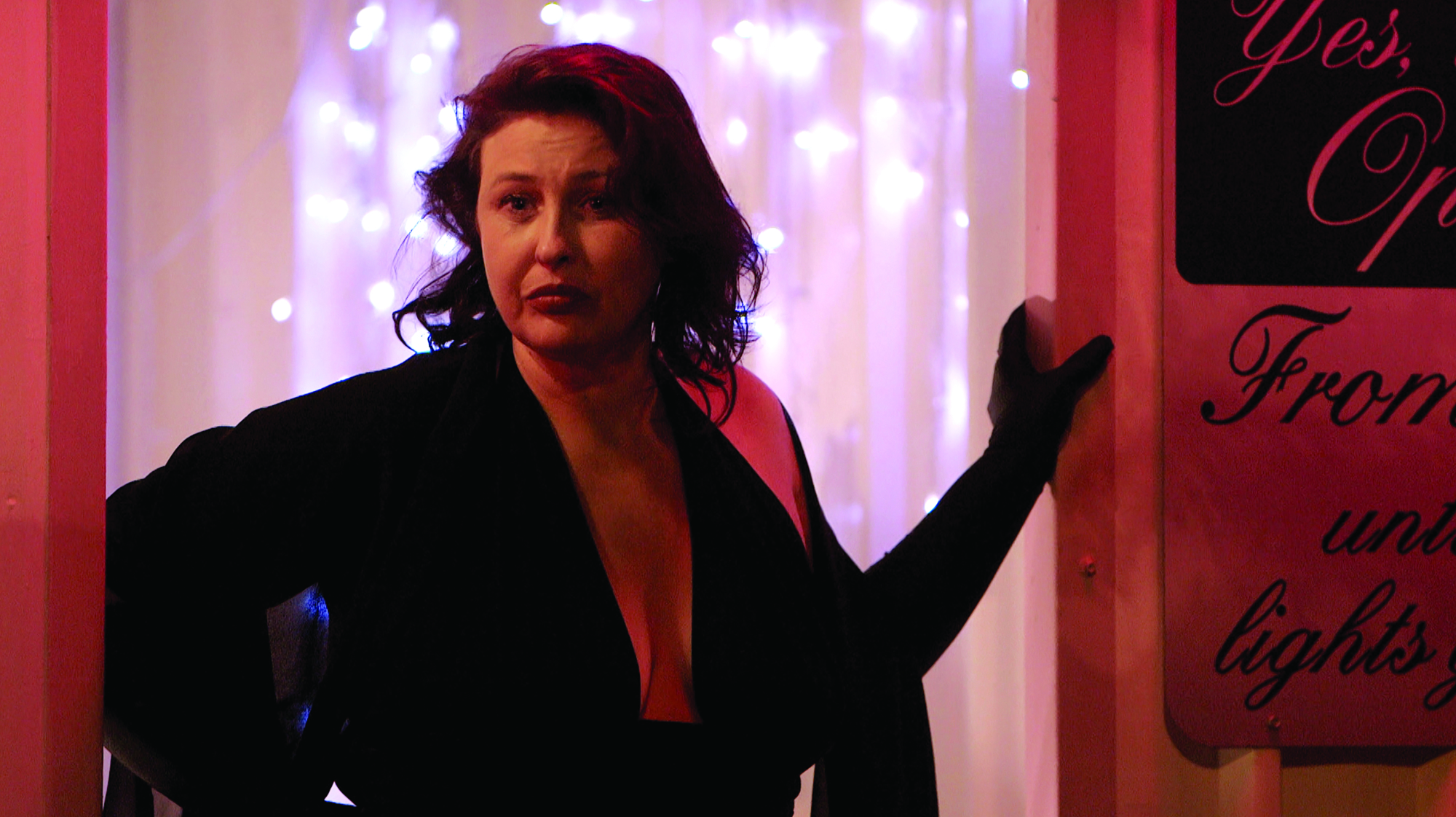Welcome to Questa Casa. I’m Carmel; I’m the madam here. My story is that I fell into a deep pit of depression when I was widowed. Went to see my lady doctor; I said, ‘I think my hormones need adjusting.’
She said, ‘There’s nothing the matter with your hormones – you go out and do something with your life.’
So I went home and I looked at all the businesses for sale […]
I [later] went to see my lady doctor; she said, ‘You’re looking much better, what have you done?’
I said, ‘I’ve bought a brothel in Kalgoorlie.’ She said, ‘Oh god, I meant for you to do charity work.’
—Madam Carmel
Questa Casa provides director/co-writer Sascha Ettinger Epstein and producer/co-writer Claire Haywood with a portal into the strange vertex of the mining and sex industries in Kalgoorlie, Western Australia. Though Kalgoorlie’s gold stores were almost exhausted by the end of the 1890s during the first gold rush, the mining industry has continued to find ways to keep the town’s output flowing by accessing deeper reserves, with the Fimiston Open Pit established by magnate Alan Bond in 1989. Shaded in soft, bright pinks, Questa Casa is a galvanised-iron building and Kalgoorlie’s last original brothel, outliving this period of tumultuous industrial change.
Having received production and development support from Screen Australia, The Pink House (2017) adheres to the dominant currents of much Australian factual programming by presenting the history of sex work’s ties to mining in Kalgoorlie through a character study of a madam and a sex worker who, despite their differences, share an unusual kinship. Carmel has a strong bond with her longest-serving staff member, BJ, which is tested over the course of the film. Both women are eccentric in their own ways, and their characterisations are essential to Epstein and Haywood’s new angle on this old story about the collision of sex and capital.
We come to know Carmel as a dignified, slightly lonely figure who oscillates between frankness and prudence when it comes to sex. ‘Well, we offer massage and oral sex,’ she says to a caller in her clipped British accent. ‘No, we’re not into anal here …’ Then she speaks to the filmmakers, who are off-camera: ‘Well, look, years ago, sex was just “natural” sex. I mean, there’s the missionary position, there’s doggy position, that’s fine. But behaving like a rooting dog, or wanting to put all sorts of things up into women’ – she shakes her head with familiar resignation – ‘I can’t see why that would excite people.’ Accompanied by her small, fluffy dog, Fifi, and smocked in an ‘I ♥ NYC’ T-shirt, Carmel is a thrice-widowed seventy-year-old who’s simply ‘waiting for the right bloke to come along’.
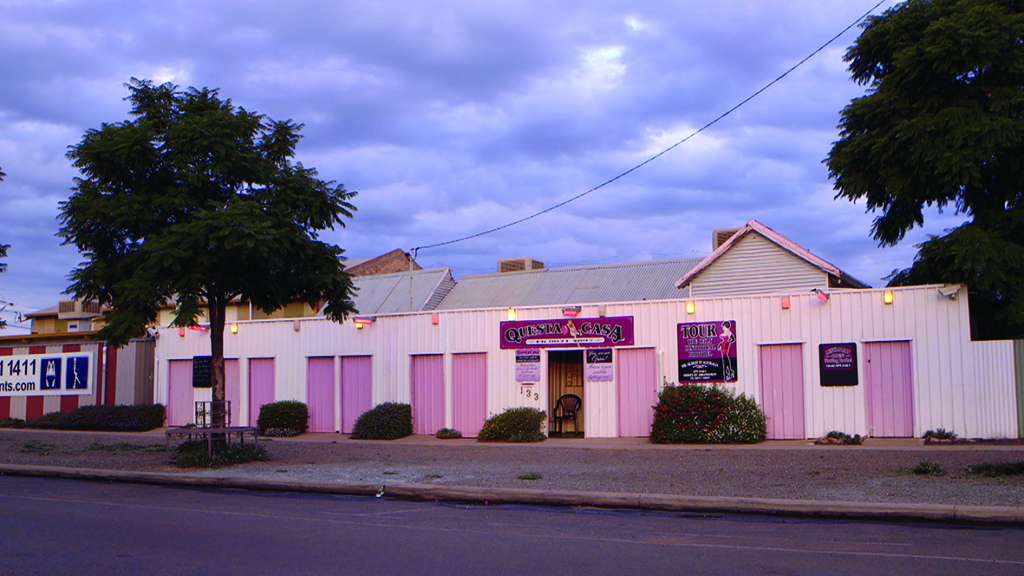
BJ has been in the industry since 1997. She describes herself as ‘a bad girl with a bad background’, and light-heartedly alludes to a personal history of homelessness and drug use. She’s not a ‘model-type’ sex worker, and describes Carmel as ‘the mother [she] never had’: ‘Carmel […] kept me straight. I think that discipline’s what I needed. I think of this house as like my home – this is where things are right for me.’ Shots of Carmel serving a homemade chicken dinner to BJ in the Casa’s back lounge room suggest that sex work can be congruent with a caring domestic life: Carmel and BJ are family.
We then see BJ, dressed in a low-cut black dress, boots and gloves, outside the Casa, chatting flirtatiously with male passers-by and posing in the dark doorframe. These lonely wide shots give us some major clues about the complications of sex work in rural areas today: BJ must advertise herself on the street to bring in customers. Business isn’t booming as it was during Kalgoorlie’s vibrant past.
Sex work on screen
A sleek, irreverent sequence of archival news clips illuminates the sex trade’s history in the town: headlines declaring the gold rush, almost cartoon-like visions of soft porn, footage showing the recent slowdown in mining caused by the 2008 global financial crisis. ‘With gold always comes prostitution,’ says one archival interviewee. It’s a sleaze city narrative that departs radically from the usual positive political discourse around mining in Australia that speaks of jobs, growth and development.
Footage is arranged in such a way as to point to the hypocrisy of politicians who are supportive of mining, but are in denial or condemning of the complex social issues that go with it. A second hypocrisy is found in the widespread disgust that is generally directed at sex workers rather than the men who buy access to those women’s bodies. Western Australian politicians are shown debating the ‘containment’ policy, formally introduced in 1975 to control commercial sexual services and rescinded in 2000,[1]See Prostitution Law Reform Working Group, Prostitution Law Reform for Western Australia, January 2007, p. 14, available at <http://www.scarletalliance.org.au/library/wa_lwp_07>, accessed 16 October 2017. as well as the possibility for brothels to apply for licences, though the long legal evolution of sex work isn’t always made clear to the viewer. While one madam wonders why nobody else in society is made to apply for a licence before having sex, the picture painted by The Pink House suggests a complicated industry that is over-regulated in some ways and under-regulated in others, with new brothels staffed by sex workers possibly trafficked from Asia popping up – much to Carmel’s and other madams’ dismay. Though largely abstract to the politicians who debate them, these legalities are shown to have profound effects on those within the industry: what happens to sex workers’ safety when their employment is sent underground or used for barter and banter in political rhetoric?
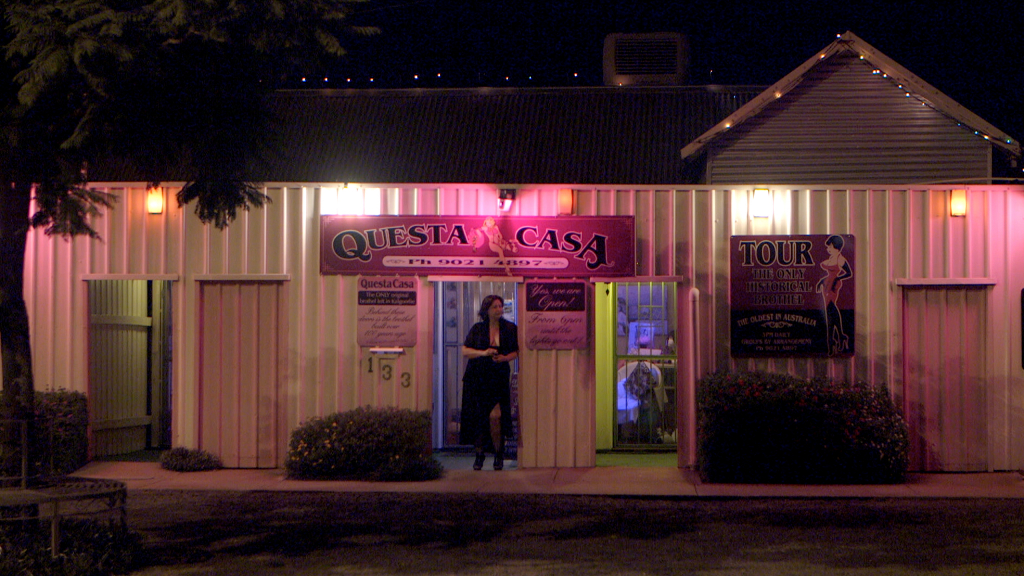
Cinema has expounded on the thematic link between mining and sex work before. Robert Altman’s McCabe & Mrs. Miller (1971) is known for both its atmosphere of terrible sadness and the strength of its narrative’s implantation in the snow-laden, grey-skied location of West Vancouver. The revisionist western – set in the early 1900s in the zinc-mining town of Presbyterian Church – follows gambler John (Warren Beatty) and sex worker Constance (Julie Christie), who partner to run a brothel, and replaces the genre’s usual shoot-’em-up sequences with blizzardy, fumbling antiaction scenes. The film builds slowly to form a drug-addled frontier lament.
On local shores, Indigenous director Ivan Sen’s last two films have set these same themes against the Australian landscape. An arthouse crime film, Mystery Road (2013) sees lonely detective Jay Swan (Aaron Pedersen) investigate the murder of a young Aboriginal woman in the outback, after she engaged in sex work with truckies on a dangerous highway. In the sequel, Goldstone (2016), the same detective is posted to a mining town where corporate corruption windingly intersects with the trafficking of Chinese sex workers.
Epstein’s film suggests that the line between exploitation and empowerment is much finer than what much of the newer discourse around sex work acknowledges.
And Pete Gleeson’s Hotel Coolgardie (2016) shows a less direct – yet obliquely damning – coming-together of mining and women’s exploitation. Set in a one-street town half an hour’s drive from Kalgoorlie, the low-budget observational documentary exposes how female backpackers forgo rights and safety at work to be used as cheap labour at the local hotel, which is frequented by lonely fly-in fly-out miners who treat them as personal geishas.
Tough lives, real people
At first, BJ is characterised as a friendly, sassy, no-nonsense sex worker, much like Rachel Wotton in Scarlet Road (Catherine Scott, 2011). This documentary explores the professional relationships between Wotton and her clients, who have serious health problems like cerebral palsy. One client’s simple dream is for a woman to sleep with him overnight in his bed; another laments that he has no girlfriend with whom he can share his feelings and thoughts. ‘Everyone has a right to sexual expression,’ says Wotton in the film, ‘and that includes people with disability.’ The documentary has contributed to reframing the public conversation about the important role that sex workers play in helping people with disabilities bridge their inner and sex lives.
But The Pink House puts forward a different, if related, narrative about the many-threaded realities of sex work in Australia. As the narrative progresses, it becomes clear that BJ does not parallel the figure of the educated, informed, supported urban sex worker presented in Scarlet Road. We learn that her entry into the industry wasn’t by choice: she was trafficked as a fourteen-year-old following a complete family breakdown. We’re shown an almost-bridal black-and-white picture of her as a teenager. Her decades-long involvement in the sex industry has been punctuated with breakdowns as she deals with drug use, her childhood traumas and the loss of four children.
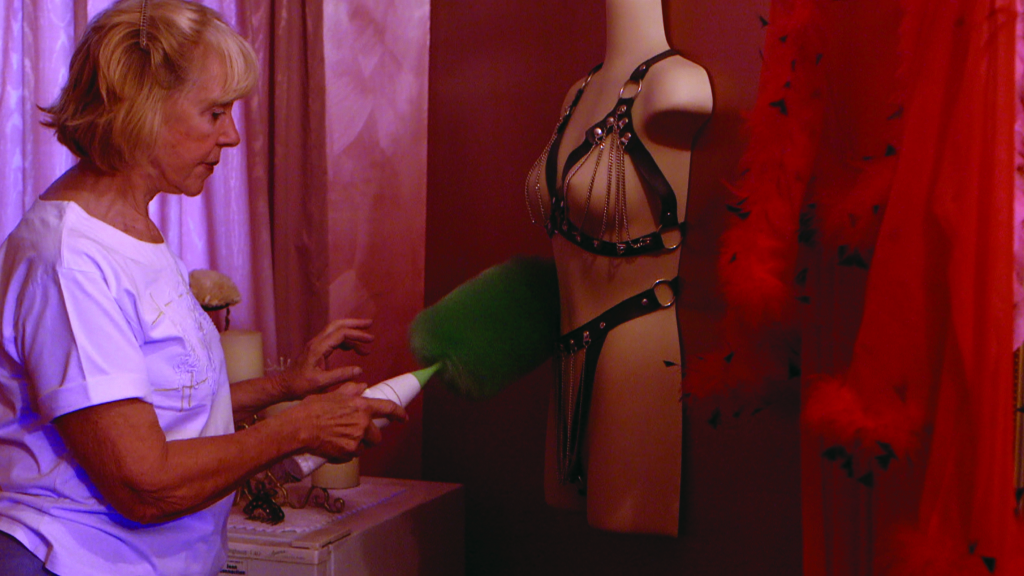
BJ’s working conditions and sense of security suffer a massive and sudden falling-away when she decides to leave Questa Casa and go freelance. Working out of her bedroom, she advertises in the local newspaper, takes bookings on her mobile phone and visits men wherever they are, often in their trucks. We hear her standard sales pitch to prospective clients: ‘I’m an older woman, forty-five years old, very sexy, give great head.’ The filmmakers make us hear it many times, and the sadness of it becomes evident in the script-like repetition. Under Carmel’s care at Questa Casa, BJ had less cause to worry about men ‘getting away with things’. Now, she’s more socially isolated than ever. Eventually, Carmel recounts that BJ told her, ‘I want to get out of this industry […] I’m sick of being fucked.’ But, without education, a union like the Scarlet Alliance, or social support from family or a partner, BJ is faced with narrow options. What other job in Kalgoorlie pays A$150 an hour? The past’s shadow remains long and dark; a range of limiting socio-economic determinants influences her decision to continue with sex work.
This form of employment may supply BJ’s income, but it’s tenuous and casual, lacking the stability of a known wage and benefits like sick leave and superannuation. Moreover, a string of highly paid jobs is often what pushes her back towards a celebratory drug binge. In capturing the devolution of BJ’s working conditions and happiness, The Pink House offers a far less rosy view of sex work in Australia than Scarlet Road and eschews the latter’s interest in personalising the clients of sex workers. Epstein’s film suggests that the line between exploitation and empowerment is much finer than what much of the newer discourse around sex work acknowledges, and is dependent on the specific employment conditions in which sex workers find themselves (in particular, the dangers of private escort work versus the security of working in a brothel).
The documentary builds to an unexpected type of tragedy when BJ falls back into drug use, moves into a sharehouse with men – trading sex for rent and drugs in an informal and dangerous variation of her profession – and becomes peripherally involved in a violent crime. Generalisations are of very little use when examining a diffuse, ill-regulated industry with diverse settings and experiences, and this turn of events in BJ’s life suggests varying degrees of self-determination on the part of the working women.
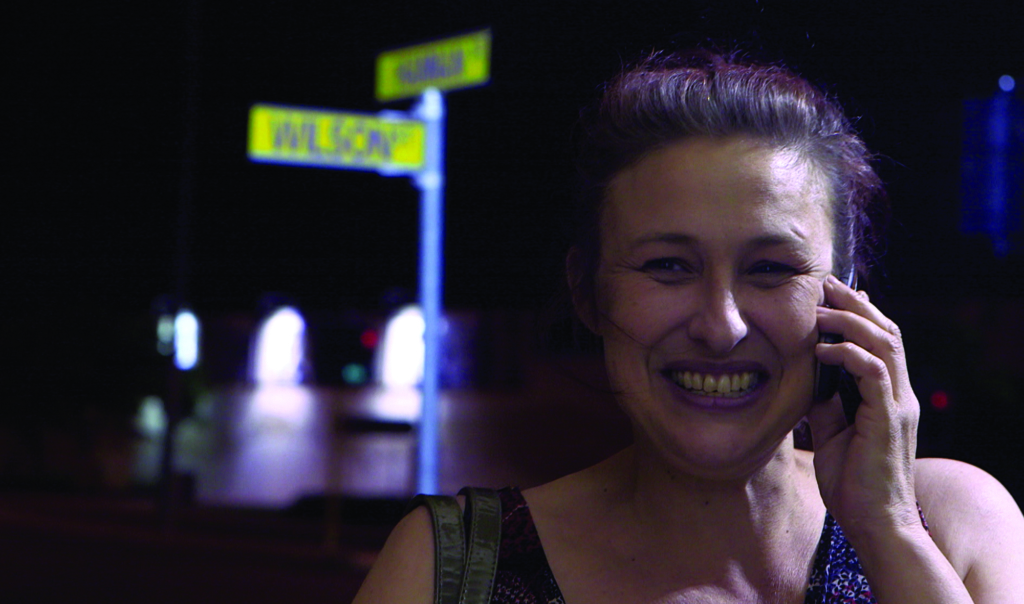
There are no easy answers to the issues presented in The Pink House. The doco at once critiques the moral hypocrisy that has consumed public discussions of the sex industry and aims to replace that destructive discourse by framing sex work as both a human enterprise and an industrial framework of legalities, policies and competing business interests. Though it complicates Scarlet Road’s narrative of empowered sex workers, The Pink House shares this earlier film’s mission of humanising rather than judging: of providing an empathetic viewpoint – through Carmel’s loneliness and BJ’s hardships – on a subject that is often hijacked for ideological gain.[2]A representative from the Australian Christian Lobby is quoted a number of times in the film to bring this point home. Both documentaries challenge mainstream perceptions that the sex industry is morally shady, instead shining a light on the individual women who work in it and survive.
Endnotes
| 1 | See Prostitution Law Reform Working Group, Prostitution Law Reform for Western Australia, January 2007, p. 14, available at <http://www.scarletalliance.org.au/library/wa_lwp_07>, accessed 16 October 2017. |
|---|---|
| 2 | A representative from the Australian Christian Lobby is quoted a number of times in the film to bring this point home. |
